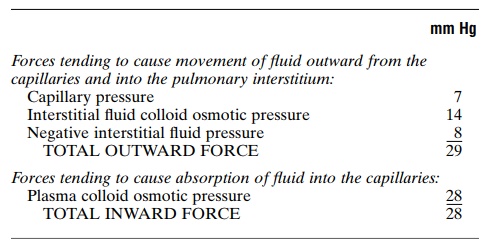Chapter: Medical Physiology: Pulmonary Circulation, Pulmonary Edema, Pleural Fluid
Capillary Exchange of Fluid in the Lungs, and Pulmonary Interstitial Fluid Dynamics
Capillary Exchange of Fluid in the Lungs, and Pulmonary Interstitial Fluid Dynamics
The dynamics of fluid exchange across the lung capillary membranes are qualitatively the same as for peripheral tissues. However,quantitatively, there are important differences, as follows:
1. The pulmonary capillary pressure is low, about 7 mm Hg, in comparison with a considerably higher functional capillary pressure in the peripheral tissues of about 17 mm Hg.
2. The interstitial fluid pressure in the lung is slightly more negative than that in the peripheral subcutaneous tissue. (This has been measured in two ways: by a micropipette inserted into the pulmonary interstitium, giving a value of about –5 mm Hg, and by measuring the absorption pressure of fluid from the alveoli, giving a value of about –8 mm Hg.)
3. The pulmonary capillaries are relatively leaky to protein molecules, so that the colloid osmotic pressure of the pulmonary interstitial fluid is about 14 mm Hg, in comparison with less than half this value in the peripheral tissues.
4. The alveolar walls are extremely thin, and the alveolar epithelium covering the alveolar surfaces is so weak that it can be ruptured by any positive pressure in the interstitial spaces greater than alveolar air pressure (greater than 0 mm Hg), which allows dumping of fluid from the interstitial spaces into the alveoli.
Now let us see how these quantitative differences affect pulmonary fluid dynamics.
Interrelations Between Interstitial Fluid Pressure and Other Pressures in the Lung. Figure 38–6 shows a pulmonarycapillary, a pulmonary alveolus, and a lymphatic capil-lary draining the interstitial space between the blood capillary and the alveolus. Note the balance of forces at the blood capillary membrane, as follows:


Thus, the normal outward forces are slightly greater than the inward forces, providing a mean filtration pressure at the pulmonary capillary membrane; thiscan be calculated as follows:

This filtration pressure causes a slight continual flow of fluid from the pulmonary capillaries into the inter-stitial spaces, and except for a small amount that evap-orates in the alveoli, this fluid is pumped back to the circulation through the pulmonary lymphatic system.
Negative Pulmonary Interstitial Pressure and the Mechanism for Keeping the Alveoli “Dry.” One of the most importantproblems in lung function is to understand why the alveoli do not normally fill with fluid. One’s first incli-nation is to think that the alveolar epithelium is strong enough and continuous enough to keep fluid from leaking out of the interstitial spaces into the alveoli. This is not true, because experiments have shown that there are always openings between the alveolar epithelial cells through which even large protein mol-ecules, as well as water and electrolytes, can pass.
However, if one remembers that the pulmonary cap-illaries and the pulmonary lymphatic system normally maintain a slight negative pressure in the interstitial spaces, it is clear that whenever extra fluid appears in the alveoli, it will simply be sucked mechanically into the lung interstitium through the small openings between the alveolar epithelial cells. Then the excess fluid is either carried away through the pulmonary lymphatics or absorbed into the pulmonary capillaries. Thus, under normal conditions, the alveoli are kept “dry,” except for a small amount of fluid that seeps from the epithelium onto the lining surfaces of the alveoli to keep them moist.
Related Topics